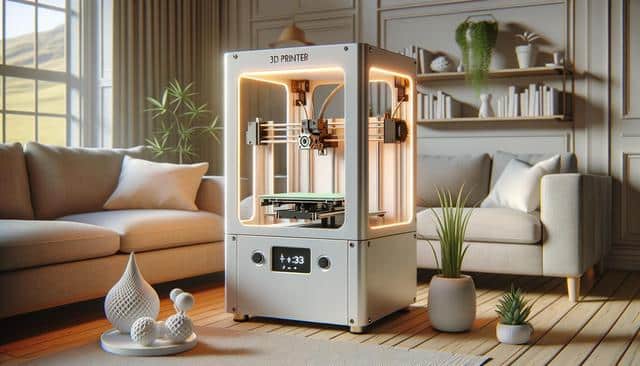Exploring 3D Printers for Home Use: A Practical Guide for Beginners and Hobbyists
The world of 3D printing for home use is becoming more accessible, offering exciting possibilities for creativity, customization, and learning.

Why Choose a 3D Printer for Personal Use?
More people are discovering the convenience and creativity 3D printers bring into their homes. Whether you’re an avid DIYer, a hobbyist, or someone curious about technology, a 3D printer for personal use opens up a world of possibilities. These machines can produce everything from household tools to decorative items, making them a versatile asset in any home setting. 3D printers for home use are especially appealing because they provide a hands-on way to design and manufacture practical objects and artistic creations alike.
As technology has evolved, home-based 3D printers have become more affordable and user-friendly. You no longer need an engineering degree to operate one. Many models now come with intuitive interfaces and support a wide range of materials, including popular filaments like Polymaker Polyterra PLA, known for its eco-friendliness and ease of use.
Benefits of having a 3D printer at home include:
- Customization of household items and tools
- Learning opportunities for children and adults
- Cost savings on parts and accessories
- Prototyping personal invention ideas
Whether you’re printing phone stands, drawer organizers, or artistic sculptures, the range of applications makes 3D printing for home use an attractive option.
Types of 3D Printers Suited for Home Use
When choosing a 3D printer for home use, understanding the types available is essential. The most common types are FDM (Fused Deposition Modeling), SLA (Stereolithography), and MJF (Multi Jet Fusion). FDM printers are the most widely used at home due to their affordability and the availability of materials like Polymaker Polyterra PLA. SLA printers offer high-resolution results, suitable for intricate designs, while MJF printing is more advanced and often used for professional-grade tasks but is beginning to see interest among serious hobbyists.
Each type has its strengths:
- FDM: Great for beginners, cost-effective, widely supported
- SLA: High detail, better suited for miniatures and dental models
- MJF: Durable parts, ideal for functional prototypes
Platforms such as Shapeways 3D printing also allow users to upload their designs and have them printed professionally using methods like MJF printing, which is helpful for projects that require higher precision or specialized materials.
Features to Consider When Buying a Home 3D Printer
If you’re looking for the biggest 3D printer for home use or something compact, several factors should guide your decision. Build volume, print quality, material compatibility, and ease of use are all critical considerations. For instance, someone aiming to create large parts may prioritize a larger build volume, while a beginner may look for an easy-to-use interface and auto-calibration features.
Key features to look for include:
- Print volume (especially if you need larger prints)
- Material support (such as PLA, ABS, PETG)
- Heated bed (helps with adhesion and reduces warping)
- Connectivity options (USB, Wi-Fi, SD card)
- Customer support and community resources
Some home users are even experimenting with the biggest 3D printer for home use to create furniture components or large-scale art pieces. While the concept of a 3D printer that builds a house remains more aligned with industrial applications, it’s fascinating to see how home-scale printing continues to push boundaries.
Applications of 3D Printing in a Home Environment
Once you’ve set up your 3D printer, you’ll quickly realize its vast range of uses. From educational tools to home repair, 3D printing for home use is both practical and inspiring. Children can learn about design and engineering through simple modeling tasks, while adults can fabricate replacement parts or design custom household items. The versatility of 3D printers for home use makes them a valuable addition to any creative or problem-solving toolkit.
Popular applications include:
- Custom phone holders, charging docks, and cable organizers
- Educational models for science and math learning
- Replacement parts for appliances or furniture
- Holiday decorations and personalized gifts
- Prototyping inventions or product ideas
Communities like Shapeways 3D printing also offer platforms where users can sell their designs or order prints they can’t produce at home, extending functionality beyond the hardware itself. For those interested in sustainability, materials like Polymaker Polyterra PLA offer a more eco-conscious way to print, aligning with responsible home use practices.
Future Trends and Considerations for Home 3D Printing
As 3D printing continues to evolve, its role in the home is expected to expand significantly. Advanced printers capable of working with new materials, improved software integration, and faster printing speeds are on the horizon. While it might still be some time before a 3D printer builds a house as a standard home appliance, innovations are gradually making such capabilities more accessible on a smaller scale.
Looking ahead, some trends worth watching include:
- Integration with smart home systems
- More sustainable materials and biodegradable filaments
- Enhanced multi-material printing options
- Growth of online communities and marketplaces
For those considering entering this space, it’s important to stay informed and start with manageable projects. Experimenting with different materials, such as Polymaker Polyterra PLA, and exploring services like Shapeways 3D printing can help expand your capabilities without a steep learning curve. The more you print, the more you’ll discover about the potential of having a 3D printer for personal use.